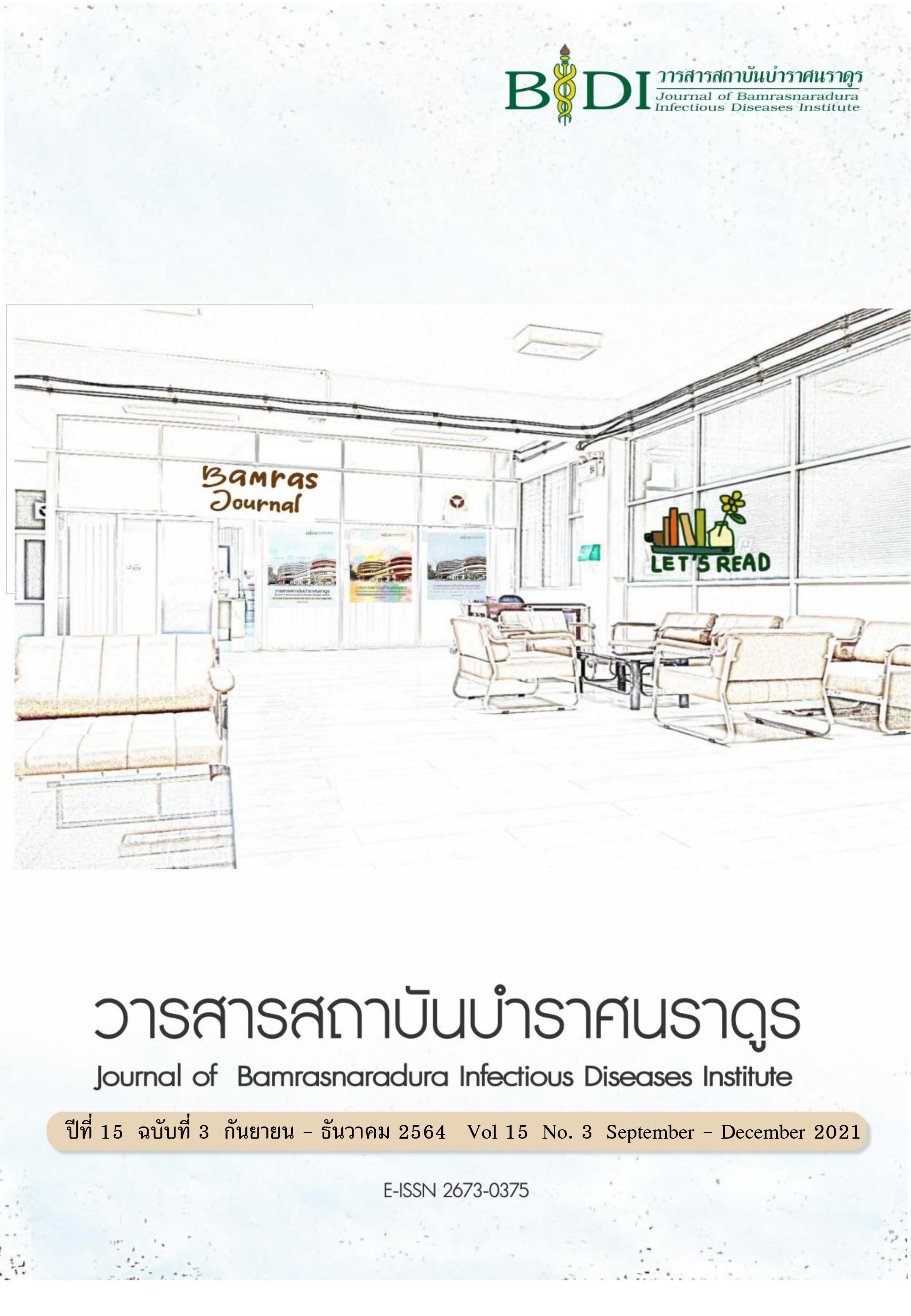โมเดลสมการโครงสร้างภาวะผู้นำการเปลี่ยนแปลง การจัดการนวัตกรรมและ ผลการดำเนินงานด้านนวัตกรรมตามการรับรู้ของผู้บริหารการพยาบาลระดับต้น โรงพยาบาลทั่วไป กระทรวงสาธารณสุข
Main Article Content
บทคัดย่อ
การวิจัยเชิงสำรวจมีวัตถุประสงค์เพื่อศึกษาความสอดคล้องโมเดลสมการโครงสร้างและอิทธิพลระหว่างภาวะผู้นำการเปลี่ยนแปลง การจัดการนวัตกรรมและผลการดำเนินงานด้านนวัตกรรมตามการรับรู้ของผู้บริหารการพยาบาลระดับต้น กลุ่มตัวอย่างคือ ผู้บริหารการพยาบาลระดับต้นจำนวน 264 คน โรงพยาบาลทั่วไป กระทรวงสาธารณสุข เลือกกลุ่มตัวอย่างแบบกลุ่มแบ่งตามภูมิภาคและสุ่มอย่างง่าย เก็บรวบรวมข้อมูลระหว่าง 14 พฤศจิกายน พ.ศ. 2562 - 15 กุมภาพันธ์ พ.ศ. 2563 เครื่องมือที่ใช้ในการวิจัยเป็นแบบสอบถามมี 4 ส่วน ประกอบด้วยข้อมูลทั่วไป ภาวะผู้นำการเปลี่ยนแปลง การจัดการนวัตกรรมและผลการดำเนินงานด้านนวัตกรรม มีค่าดัชนีความตรงเชิงเนื้อหาเท่ากับ 1.0, .85 และ.96 ค่าความเชื่อมั่นสัมประสิทธิ์แอลฟาของครอนบาคเท่ากับ .96, .98 และ 98 ตามลำดับ วิเคราะห์ข้อมูลด้วยสถิติเชิงพรรณนา และสถิติวิเคราะห์โมเดลสมการเชิงโครงสร้างด้วยโปรแกรมลิสเรล
ผลการวิจัยพบว่า ผู้บริหารการพยาบาลระดับต้นมีค่าคะแนนเฉลี่ยการรับรู้ภาวะผู้นำการเปลี่ยนแปลง การจัดการนวัตกรรมและและผลการดำเนินงานด้านนวัตกรรมอยู่ในระดับมาก (= 3.23 SD = .45 = 3.12, SD = .48 = 2.67 SD = .43) โมเดลสมการโครงสร้างตามสมมติฐานมีความสอดคล้องกับข้อมูลเชิงประจักษ์ (c2/df = 1.62, GFI = 0.94, AGFI = 0.91, CFI = 0.99, SRMR = 0.03, RMSEA = 0.04) ภาวะผู้นำการเปลี่ยนแปลงมีอิทธิพลทางตรงต่อผลการดำเนินงานด้านนวัตกรรม (β = .38, p<.01) มีอิทธิพลทางอ้อมต่อผลการดำเนินงานด้านนวัตกรรมส่งผ่านการจัดการนวัตกรรม (β = .52, p<.01) และมีอิทธิพลรวมต่อผลการดำเนินงานด้านนวัตกรรมอย่างมีนัยสำคัญทางสถิติ (TE =.90, p<.01) สามารถอธิบายความแปรปรวนของผลการดำเนินงานด้านนวัตกรรมได้ร้อยละ 89 (R2 = .89)
ข้อเสนอแนะผลการวิจัยนี้ชี้ให้เห็นว่า การบริหารผลการดำเนินงานด้านนวัตกรรมจะเกิดได้ตามเป้าหมายขององค์กร ผู้บริหารการพยาบาลต้องมีความสามารถในการจัดการนวตกรรมในองค์กรที่ชัดเจน โดยใช้อิทธิพลที่มีลักษณะของภาวะผู้นำการเปลี่ยนแปลงในการสร้างแรงบันดาลใจ การกระตุ้นความคิดใหม่ๆเพื่อให้เกิดผลการดำเนินงานด้านนวัตกรรมต่อไป
Article Details
เอกสารอ้างอิง
David, R. L., Ross, L. C., & Terry, R. S. Inter-relationship between innovational and market orientation in SMEs. Management Research News 2007; 30(12): 878-891.
Goffin, K., & Mitchell, R. Innovation Management: strategy and implementation using the pentathlon framework. 2nded. Palgrave Macmillan: Basingstoke; 2010.
Drucker, P. F. The Discipline of Innovation. Harvard Business review 2002; 80(8): 95-103.
Lilly, L. & Juma, D. Influence of Strategic Innovation on Performance of Commercial Banks in Kenya: The Case of Kenya Commercial Bank I Nairobi Country. European Journal of Business Management 2014; 2(1): 336-341.
World Health Organization. World Health Organization Global strategic directions for Strengthening nursing and midwifery 2016–2020. Available from: https://who.int/publications/i/item/978-92-4-151604-4.
Nursing Division, Office of the Permanent Secretary, Ministry of Public Health. National Nursing Service Strategy 2017 – 2021 according to the 20-year National Strategic Plan (Public Health). Bangkok: Printing and delivery organization; 2018.
Khan, Z. A, Nawazl, A., & Khan, I. The Impact of leadership style on innovation in health service, Gomal University. Journal of Research 2015; 31(1): 143-145.
Zhang, Y., Zheng, J., & Darko, A. How does transformational leadership promote innovation in construction? the mediating role of innovation climate and the multilevel moderation role of project requirements. Sustainability 2018; 10: 1-19.
AKay, E. & Demirel, A. G. Transformational Leadership and Innovation: An Empirical Study of Direct and Indirect Effects in HR Consulting Companies. International Journal of Business and Management 2018; 13(1): 1833-8119.
Mokekhaow, K, Luangamornlert, S., Chintanadilok, N, & Sritoomma, N. The relationship Model among Transformational Leadership, Knowledge Creation and Innovation Management Performance in Nursing Units at Community Hospitals. Nursing Journal of the Ministry of Public Health [internet]. 2018 [cited 2021 Oct 28]; 27(3): 163-75. Available from: https://he02.tci-thaijo.org/index.php/tnaph/article/view/111209 (in Thai)
Adams, R., Bessant, J., & Phelps, R. Innovation management measurement: A review. International Journal of Management Reviews 2006; 8(1): 21-47.
Bass, B. M. From Transactional to Transformational Leadership: Learning to Share the Vision. Organizational Dynamics 1990; 18, 19-32.
Tidd, J. & Bessant, J. Managing Innovation: Integrating Technological, Market, and Organizational Change. 4thed. John Wiley & Sons Limited: London; 2009.
Birchall D, Chanaron J, Tovstiga G, Hillenbrand C. Innovation performance measurement: current practices, issues and management challenges. Int. Journal Technology Management 2011; 56(1): 1-20.
Office of Public Health Administration. Office of the Permanent Secretary, Ministry of Public Health. Health Service Development Plan (Service Plan) 2018-2022. Bangkok: Cooperative Union Printing House. Agriculture of Thailand; 2016. (in Thai)
Krejcie, R. V. & Morgan, D. W. Determining sample size for research activities. Educational and Psychological Measurement 1970; 30: 607-610.
Gupta, K. K., Attri, J.P., Singh, A., Karu, H., & Karu, G. Basic concepts for sample size calculation: Critical step for any clinical trials. Saudi J Anaesth. 2016; 10(3), 328-331.
Sriboonwong, L, Singchangchai, P and Aree, P. The relationship model between the transformational leadership of head nurses. behavior to create innovation in work and performance according to duties According to the perception of professional nurses in general hospitals. Journal of Cardiovascular and Thoracic Nurses. 2019; Vol. 31, No. 2 July-December 2020. (in Thai)
Hair, J.F., Black, W.C., Babin, B.J. & Anderson, R.E. Multivariate Data Analysis. 7th ed. Pearson: New York. 2010.
Schumacker, R. E. & Lomax, R. G. A beginner’s guide to structural equation modeling. 3rd ed. New Jersey: Lawrence Erlbaum Associates. 2010.
Thanomsaksri, N, Singchangchai, P, & Pathumarak, N. Factors Influencing Innovation Performance in Nursing Organizations as Perceived by Head Nurses of Community Hospitals under the Ministry of Public Health. Journal of Health and Nursing Research. 36(2), May-August 2020. (In Thai)
Smith, M., Busi, M., Ball, P., & Meer, R. (2008). Factors Influencing an Organization ability to Manage Innovation: a Structured Literature Review and Conceptual Model. International Journal of Innovation Management, 2008. 12, 655-76.
Naguib, H. M. & Abou Naem, A. E. (2018). The impact of transformational leadership on the organizational innovation. The International Journal of Social Sciences and Humanities Invention, 5(01), January, 2018. DOI: 10.18535/ijsshi/v5i1.15
Chen, D. X., & Peng, X. B. Research on the Relationship between Transformational Leadership and Government Service Innovation. Open Journal of Leadership. 2017. 6, 82-94. ttps://doi.org/10.4236/ojl.2017.62005
Tang H. Effects of Leadership Behavior on Knowledge Management and Organization Innovation in Medicine and Health Science. EURASIA Journal of Mathematic Science and Technology Education, 2017. ISSN: 1305-8223 (online). 13(8), 5425-5433. DOI: 10.12973/Eurasia.2017.00840a
Noruzy, A., Dalfard, V. M., Azhdari, B., Nazari-Shirkouhi, S., & Rezazadeh, A. Relations between transformational leadership, organizational learning, knowledge management, organizational innovation, and organizational performance: an empirical investigation of manufacturing firms. Int J Adv Manuf Technol, 2013. 64, 1073–1085. DOI 10.1007/s00170-012-4038-y.
Klaywong, C, & Pungnirund, B. The Influences of Transfomational Leadership, Orgnanizational Innovation and Chang Management on Private Hospital Performance in Thailand. Journal of Social Science and Buddhistic Anthropology. 5(4), 2020, 127-144.
Gumusluoglu, L. and Ilsev, A. Transformational leadership and organizational innovation: The roles of internal and external support for innovation. The Journal of Product Innovation Management, 2009. 26, 264-277.


